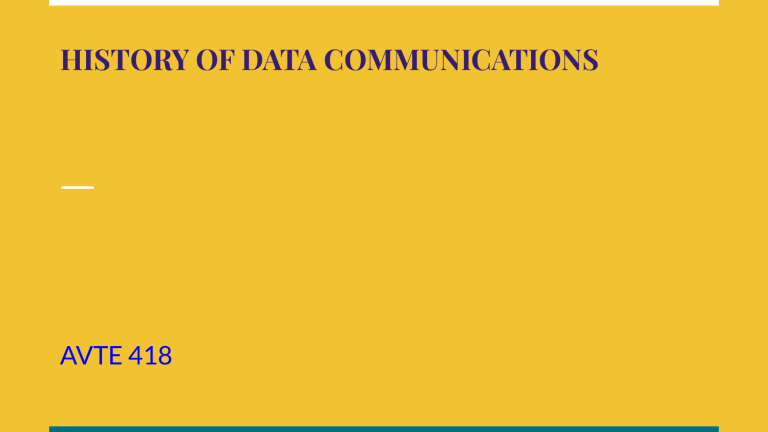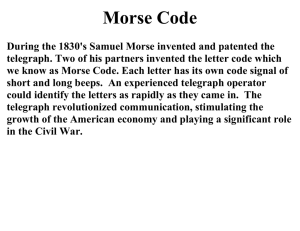
HISTORY OF DATA COMMUNICATIONS AVTE 418 HISTORY OF DATA COMMUNICATIONS It is highly likely that data communications began long before recorded time in the form of smoke signals or tom-tom drums, although they surely did not involve electricity or an electronic apparatus and it is highly unlikely that they were binary coded. One of the earliest means of communicating electrically coded information occurred in 1753, when a proposal submitted to a Scottish magazine suggested running a communications line between villages comprised of 26 parallel wires, each wire for one letter of the alphabet. A Swiss inventor HISTORY OF DATA COMMUNICATIONS constructed a prototype of the 26-wire system but current wire-making technology proved the idea impractical. In 1833 Carl Friedrich Gauss developed an unusual system based on a five-by-five matrix representing 25 letters (I and J were combined). The idea was to send messages over a single wire by deflecting a needle to the right or left between one and five times. HISTORY OF DATA COMMUNICATIONS Carl Friedrich Gauss HISTORY OF DATA COMMUNICATIONS The initial set of deflections indicated a row and the second set indicated a column. Consequently it could take as many as 10 deflections to convey a single character through the system. If we limit the scope of data communications to methods that use binary-coded electrical signals to transmit information then the first successful (and practical) data communications system was invented by Samuel F. B. Morse in 1832 and called the telegraph. HISTORY OF DATA COMMUNICATIONS Samuel F. B. Morse Telegraph HISTORY OF DATA COMMUNICATIONS Morse also developed the first practical data communications code, which he called the Morse code. With telegraph dots and dashes (analogous to logic 1s and 0s) are transmitted across a wire using electromechanical induction. Various combinations of dots, dashes and pauses represented binary codes for letters, numbers and punctuation marks. Because all codes did not contain the same number of dots and dashes, Morse’s system HISTORY OF DATA COMMUNICATIONS combined human intelligence with electronics as decoding was dependent on the hearing and reasoning ability of the person receiving the message. (Sir Charles Wheatstone and Sir William Cooke allegedly invented the first telegraph in England but their contraption required six different wires for a single telegraph line.) HISTORY OF DATA COMMUNICATIONS Cooke and Wheatstone HISTORY OF DATA COMMUNICATIONS In 1840, Morse secured an American patent for the telegraph and in 1844 the first telegraph line was established between Baltimore and Washington D.C. with the first message conveyed over this system being “What hath God wrought!”. In 1849 the first slow-speed telegraph printer was invented but it was not until 1860 that high-speed (15-bps) printers were available. In 1850, Western Union Telegraph Company was formed in Rochester, New York for the purpose of carrying coded HISTORY OF DATA COMMUNICATIONS HISTORY OF DATA COMMUNICATIONS messages from one person to another. In 1874, Emile Baudot invented the telegraph multiplexer, which allowed signals from up to six different telegraph machines to be transmitted simultaneously over a single wire. The telephone was invented in 1876 by Alexander Graham Bell and unfortunately, very little new evolved in telegraph until 1899, when Guglielmo Marconi succeeded in sending radio (wireless) telegraph messages. HISTORY OF DATA COMMUNICATIONS Telegraph was the only means of sending information across large spans of water until in 1920, when the first commercial radio stations carrying voice information were installed. It is unclear exactly when the first electrical computer was developed. Konrad Zuis, a German engineer, demonstrated a computing machine sometime in the late 1930s: however, at that time, Hitler was preoccupied trying to conquer the rest of the world, so the project HISTORY OF DATA COMMUNICATIONS Baudot Graham Bell Marconi HISTORY OF DATA COMMUNICATIONS fizzled out. Bell Telephone Laboratories is given credit for developing the first-special purpose computer in 1940 using electromechanical relays for performing logical operations. However, J. Presper Eckert and John Mauchley at the University of Pennsylvania are given credit by some for beginning modern-day computing when they developed the ENIAC computer on February 14, 1946. HISTORY OF DATA COMMUNICATIONS Konrad Zuis Bell Telephone Laboratories HISTORY OF DATA COMMUNICATIONS Eckert and Mauchley ENIAC HISTORY OF DATA COMMUNICATIONS In 1949, the U. S. National Bureau of Standards developed the first all-electronic diode-based computer capable of executing stored programs. The U. S. Census Bureau installed the machine, which is considered the first commercially produced American computer. In the 1950s, computers used punch cards for inputting information, printers for outputting information and magnetic tape reels for permanently storing information. HISTORY OF DATA COMMUNICATIONS These early computers could process only one job at a time using a technique called batch processing. The first general-purpose computer was an automatic sequence-controlled calculator developed jointly by Harvard University and International Business Machines (IBM) Corporation. The UNIVAC computer, built in 1951 by Remington Rand Corporation, was the first mass-produced electronic computer. HISTORY OF DATA COMMUNICATIONS International Business Machines Corporation UNIVAC HISTORY OF DATA COMMUNICATIONS In the 1960s, batch processing systems were replaced by on-line processing systems with terminals connected directly to the computer through serial or parallel communications lines. The 1970s introduced microprocessor-controlled microcomputers, and by the 1980s personal computers became an essential item in the home and workplace. Since then, the number of mainframe computers, small business computers, personal HISTORY OF DATA COMMUNICATIONS computers, and computer terminals has increased exponentially, creating a situation where more and more people have the need (or at least think they have the need) to exchange digital information with each other. Consequently, the need for data communications circuits, networks, and systems has also increased exponentially. HISTORY OF DATA COMMUNICATIONS Soon after the invention of the telephone, the American Telephone and Telegraph Company (AT&T) emerged providing both long-distance and local telephone service and data communications service throughout the United States. The vast AT&T system was referred to by some as the “Bell System” and by others as “Ma Bell”. During this time, Western Union Corporation provided telegraph service. Until 1968, the AT&T operating tariff HISTORY OF DATA COMMUNICATIONS allowed only equipment furnished by AT&T to be connected to AT&T lines. In 1968, a landmark Supreme Court decision, the Carterfone decision, allowed non-Bell companies to interconnect to the vast AT&T communications network. This decision started the interconnect industry, which has led to competitive data communications offerings by a large number of independent companies. In 1983, as a direct result of an antitrust suit filed by the federal government, AT&T agreed in a court settlement to divest itself of operating HISTORY OF DATA COMMUNICATIONS companies that provide basic local telephone service to the various geographic regions of the United States. Since the divestiture, the complexity of the public telephone system in the United States has grown even more involved and complicated. Recent developments in data communications networking, such as the Internet, Intranets and the World Wide Web (www), have created a virtual explosion in the data communications industry. A seemingly infinite number of people, from homemaker to chief executive officer, now feel a need to communicate over a finite HISTORY OF DATA COMMUNICATIONS Internet, Intranet World Wide Web HISTORY OF DATA COMMUNICATIONS number of facilities. Thus, the demand for higher-capacity and higher-speed data communications systems is increasing daily with no end in sight. The Internet is a public data communications network used by millions of people all over the world to exchange business and personal information. The Internet began to evolve in 1969 at the Advanced Research Projects Agency (ARPA). ARPANET was formed in the late 1970s to connect sites around the United States. From the mid-1980s to April 30, 1995, the National Science Foundation (NSF) funded a high-speed backbone called HISTORY OF DATA COMMUNICATIONS ARPA NSF HISTORY OF DATA COMMUNICATIONS NSFNET. Intranets are private data communications networks used by many companies to exchange information among employees and resources. Intranets normally are used for security reasons or to satisfy specific connectivity requirements. Company intranets are generally connected to the public Internet through a firewall, which converts the intranet addressing system to the public Internet addressing system and provides security functionality by filtering incoming and outgoing traffic based on HISTORY OF DATA COMMUNICATIONS addressing and protocols. The World Wide Web (www) is a server-based application that allows subscribers to access the services offered by the Web. Browsers, such as Netscape Communicator and Microsoft Internet Explorer, are commonly used for accessing data over the www.




